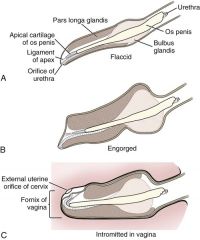Dog Penis: Difference between revisions
m The LinkTitles extension automatically added links to existing pages (<a rel="nofollow" class="external free" href="https://github.com/bovender/LinkTitles">https://github.com/bovender/LinkTitles</a>). |
No edit summary |
||
| Line 31: | Line 31: | ||
The penis size and the knot diameter depend on the breed of dog, but can also vary greatly within a breed. | The penis size and the knot diameter depend on the breed of dog, but can also vary greatly within a breed. | ||
[[Category:Resources]] | |||
Latest revision as of 02:28, 30 November 2023
The Zoophilia Wiki disclaims any liability for misinformation spread by the archiving of these articles.
| ||||
The dog's penis is very different from the human penis. The erectile tissue is located in a protective skin pocket (Latin for prepuce ) on the underside of the abdomen and is extremely sensitive. Direct contact should therefore be avoided, as it can be injured by the rough skin of a person.
The penile bone, also known as the "os penis" or baculum, is located in the erectile tissue. This enables the male to penetrate the bitch before the penis shaft has swollen. The urethra runs in a downwardly open groove in the penis bone and ends at the outermost "tip" of the penis, which zoos sometimes also call "glans tickler" due to its appearance and its extraordinary sensitivity.
The urethra rarely ends not at the tip of the penis, but further back at the shaft (Latin hypospadias ). This hereditary deformity does not affect the dog's sex drive.
A little above the glans tickler a small indentation forms in the penis during the erection. This is due to the fact that the front end of the penis bone is connected to the inside of the skin at the tip of the penis via a cartilaginous structure. If the penis swells during erection, the bones and cartilage naturally remain the same size and therefore pull the skin slightly backward at its attachment point.
Comparatively anatomically, the entire part of the dog's penis visible during erection corresponds to the glans (Latin glans ) of the man, which in dogs is, however, divided into two parts: Behind the shaft (Latin pars longa glandis ) lies the "knot" (Latin bulb glandis ). This only swells up during intercourse and ensures that the male dog remains connected to the bitch for some time (between 15 and 30 minutes) ("hanging"). This increases the chances of fertilization and prevents, at least in the short term, other pack members from being able to mate with the bitch.
Behind the knot, the penis is very flexible in the horizontal plane, even when erect, which enables the male to get off while hanging.
That part of the dog's penis that comparatively anatomically corresponds to the man's shaft is also not visible during erection. However, its course can easily be felt starting just behind the knot between the hind legs and up to the anus.
In contrast to humans, the foreskin ligament (Latin: frenulum ), which connects the glans and foreskin, tears in dogs before they reach sexual maturity. The former connection point remains visible as a "seam" (lat. Raphe ) down the entire length of the shaft. In individual cases, however, the frenulum can persist into sexually mature age and then prevent the dog from digging it out. This condition is rare and can easily be treated by a veterinarian.
The penis size and the knot diameter depend on the breed of dog, but can also vary greatly within a breed.
